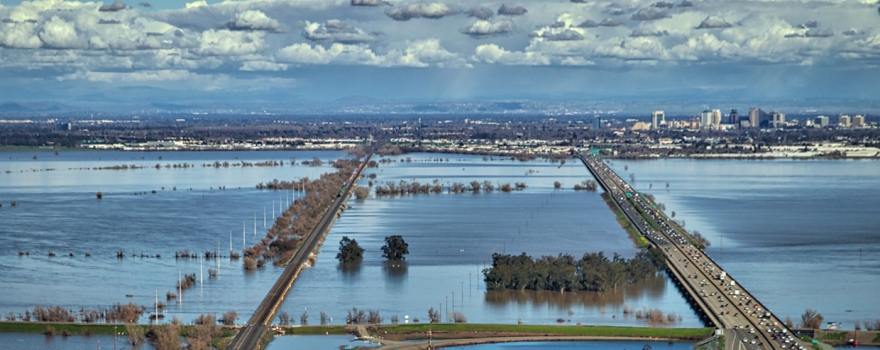
In science news this week:
Yolo Bypass: Restoration in the largest seasonal floodplain in the West benefits all Californians: “There’s a buzz of activity in the Yolo Bypass surrounding crucial habitat restoration projects. One project is essentially finished; another is under construction and four others are deep into the planning process. There is almost too much activity in the Yolo Bypass Basin these days to keep track. But when that means critical habitat restoration is occurring to help fish in one of the state’s most important systems, all of California benefits. The Yolo Bypass is a critical part of the state’s flood control system, receiving flood waters from major waterways including the American, Sacramento, and Feather rivers. When flooded, the bypass becomes one of the largest seasonal floodplains in the Delta, and a migration corridor for dozens of native fish species including Chinook salmon, steelhead, and green sturgeon. ... ” Read more from the US FWS here: Yolo Bypass: Restoration in the largest seasonal floodplain in the West benefits all Californians
Less muddy waters: Declining wind speed and turbidity in the Delta: “Climate change is affecting the environment in many ways, including raising sea levels, increasing ocean temperatures and acidification, and increasing air temperatures. But less well known is that it is also reducing average global wind speed – a worldwide phenomenon with consequences for the turbidity of the San Francisco Bay Estuary, and fishes that depend on its muddy waters. A recent review of historical climate data found a number of wind-related changes: jet streams have risen in altitude and shifted poleward in both hemispheres, and the average annual wind speeds appear to have slowed in the western and southwestern United States, as well as along the Atlantic seaboard. ... ” Read more from FishBio here: Less muddy waters: Declining wind speed and turbidity in the Delta
Rain-on-snow flood risk to increase in many mountain regions of the western U.S., Canada: “Flooding caused by rain falling on snowpack could more than double by the end of this century in some areas of the western U.S. and Canada due to climate change, according to new research from the University of Colorado Boulder and the National Center for Atmospheric Research (NCAR). The greatest flood risk increases are projected for the Sierra Nevada, the Colorado River headwaters and the Canadian Rocky Mountains — places where residents are no strangers to flood concerns. Conversely, lower elevations in coastal regions of California, Oregon, Washington and maritime British Columbia could see decreases in rain-on-snow flood risk. … ” Read more from Science Daily here: Rain-on-snow flood risk to increase in many mountain regions of the western U.S., Canada
Serenity in the slough: Sea otters lure the world to tiny coastal town: “Joonya Lopez steers his quiet, 22-foot electric boat carefully around the boat docks, coming up parallel to a group of a hundred or so harbor seals basking in rays of sunlight peeking through an overcast sky. The bank is teeming with wildlife, from pelicans and cormorants to gulls and other seabirds. It’s a serene morning at Elkhorn Slough, one of the largest wetlands in the state of California. It’s 20 miles north of Monterey in the town of Moss Landing, population 204. Gena Bentall raises her binoculars to get a closer look at kayakers near a group of sea otters resting in the water. She likes what she sees. “They’re doing exactly what they’re supposed to be doing: staying parallel, about 20 meters away from the otters so as not to disturb them,” she says. … ” Read more from US FWS here: Serenity in the slough: Sea otters lure the world to tiny coastal town
Rare Shorebird Chicks Successfully Fledge at Huntington State Beach for First Time in Decades: “For the first time in more than five decades, two pairs of federally threatened Western snowy plovers nested, nurtured and successfully fledged four chicks at one of the most popular public beaches in California – Huntington State Beach in Orange County. During routine shorebird monitoring in May, California State Parks biologists found a pair of adult plovers with two chicks within Least Tern Natural Preserve, a 12.4 acre segment of protected beach habitat at Huntington State Beach reserved for endangered shorebirds. Two days later, a group of students participating in a beach cleanup discovered a second plover nest on the outskirts of the Preserve. Biologists, in partnership with volunteer docents from Sea and Sage Audubon, continued to monitor the growing plover chicks. This week they reported all three chicks from the second nest fledged. One chick from the first nest fledged earlier this month. … ” Read more from the US FWS here: Rare Shorebird Chicks Successfully Fledge at Huntington State Beach for First Time in Decades
Mojave Desert bird populations plummet as region warms and dries: “The Mojave Desert in California and Nevada has lost 42 percent of its bird species in the past century, most likely due to the effects of climate change, according to a new study. Researchers from the University of California, Berkeley, did a three-year bird survey in the Mojave that duplicated surveys conducted from 1908 to 1947 by zoologist Joseph Grinnell and his students. The current study showed that the 61 sites resurveyed lost, on average, 43 percent of the species that were there a century ago. … ” Read more from Yale 360 here: Mojave Desert bird populations plummet as region warms and dries
Florida’s war against toxic algal blooms: “If you follow the news, you’ve seen large-scale harmful algal blooms (HABs) in Florida this summer. They are present in Lake Okeechobee and the Caloosahatchee (CE) and St. Lucie (SLE) estuaries and rivers, and they’re wreaking havoc on summer recreation and even the health of local residents. Dr. Brian Lapointe of Florida Atlantic University’s Harbor Branch has been researching HABs for decades. The Lapointe HAB Lab site features his ongoing work, and Dr. Lapointe took the time to speak with EM about the HABs and his work studying them. … ” Read more from Environmental Monitor here: Florida’s war against toxic algal blooms
Maven’s XKCD Comic Pick of the Week …
 Sign up for daily email service and you’ll never miss a post!
Sign up for daily email service and you’ll never miss a post!
Sign up for daily emails and get all the Notebook’s aggregated and original water news content delivered to your email box by 9AM. Breaking news alerts, too. Sign me up!
About Science News and Reports: This weekly feature, posted every Thursday, is a collection of the latest scientific research and reports with a focus on relevant issues to the Delta and to California water, although other issues such as climate change are sometimes included. Do you have an item to be included here? Submissions of relevant research and other materials is welcome. Email Maven


